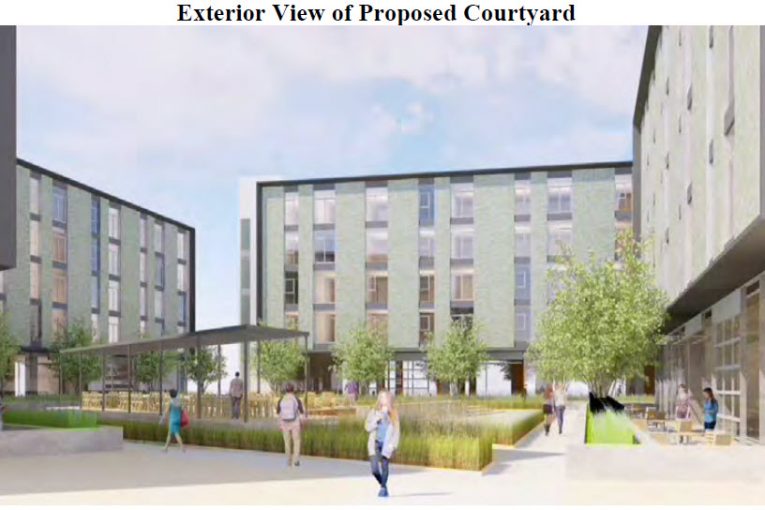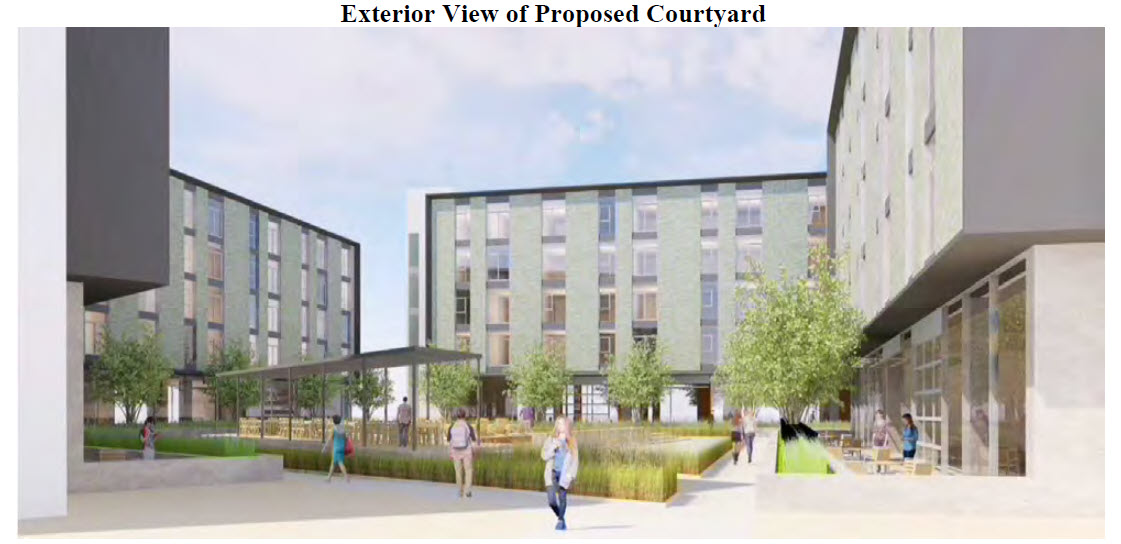

Two years ago, representatives from the University Research Park told the Vanguard that as the then-newly purchased business park by Fulcrum looked to redevelop, one of the key needs was to generate housing for existing employees at the park.
Over the summer it was a narrow 4-3 vote by the Planning Commission to recommend the University Research Park Mixed Use project.
The applicant is proposing a roughly 30,000-square-foot project—four buildings each with four floors of residential apartment units over one floor of office and tech space.
It would include 160 dwelling units—32 studio units, 96 one-bedroom units, and 32 two-bedroom units. The project would provide a total of 138,431 square feet of residential space and 26,912 square feet of office/open plan tech. The building height would be 60 feet and the buildings would surround a common open space area.
The project is located on two vacant parcels within the URP on Research Park Drive directly south of I-80. It is surrounded by hotels and retail use to the west, a hotel to the south, and the Yolo Hospice Center and the Yolo Solano Air Quality Maintenance District offices to the east.
On affordable housing, the city made the determination that the project “qualifies for the Vertical Mixed Use Exemption pursuant to Section 18.05.080 of the City’s Municipal Code that was in effect for this project at the time of the application submittal in March 2018.
“Although the City’s Affordable Housing Ordinance was amended in January 2019 with current requirements which included revisions to the exemptions, the proposed project was submitted prior to the amendments,” the city staff reasons, but they will require under the Sustainable Communities Project guidelines that “the provision of affordable housing be included as part of the project, regardless of local waivers. Therefore, the applicant has proposed that the payment of in-lieu fees to satisfy the requirement for affordable housing.”
That was one of the issues of concern by the Planning Commission.
Emily Shandy said, “I share the concerns raised previously about affordable housing in this project. I have a strong preference to see those affordable units included on site in this project. That’s the main sticking point for me on this one.”
Darryl Rutherford expressed frustration on the affordable housing after speaking to Mark Friedman of Fulcrum, and he felt there was a real need to include housing on site.
But Greg Rowe argued, “We all need to sort of step back in the concerns we have about affordable housing.” He noted that this was the outcome of attempting to address the issue of climate change and encouraging transit priority projects.
He noted that this was the result the state streamlining CEQA projects that demonstrate they would reduce VMT by being near high quality transit. Part of that trade off is reduced CEQA requirements (for which this project was CEQA exempt) and they also had a maximum of five percent affordable housing under state law.
“It’s a trade off,” he said. “We may not be happy with that… but that’s what our state legislature decided they wanted.” He said, “It’s a balancing act. It is what it is.”
There were also concerns about the aesthetics of the property.
Mark Friedman, the applicant, pushed back on some of these comments. One of the conundrums they have is how to meet many competing objectives.
“When we put this project together we were very focused on a number of benefits that we thought were important to the community,” Friedman explained. “One of the things we wanted to do was to densify the site. We felt it was an environmental good to create a place where people could walk to work.”
He noted that it is extraordinarily more expensive to build high than is to spread out. This was acknowledged in the city ordinance that had exempted mixed-use development from having to provide affordable housing. That was an acknowledgement that this project was more expensive and there were other benefits that they chose that outweighed those.
He said that he could agree to add more affordable housing and other bells and whistles, “but all I’m doing is getting further from the feasibility and farther away from delivering housing.”
He told David Robertson that he appreciates his comments. “But quite frankly I don’t understand how the community is better off, how you solve your housing problems by making projects so infeasible that nobody builds them.”
Friedman put it bluntly, “I ask you to vote this project up or down. I promise that it will be beautiful if you allow us to build it. But I’m not willing to redesign it.”
Now the project will go before the council, a week before voters decide on contested elections involving two of the five councilmembers.
—David M. Greenwald reporting
Support our work – to become a sustaining at $5 – $10- $25 per month hit the link:


Ugly apartment building on a soon-to-be-former commercial site.
It’s so . . . . . . plain